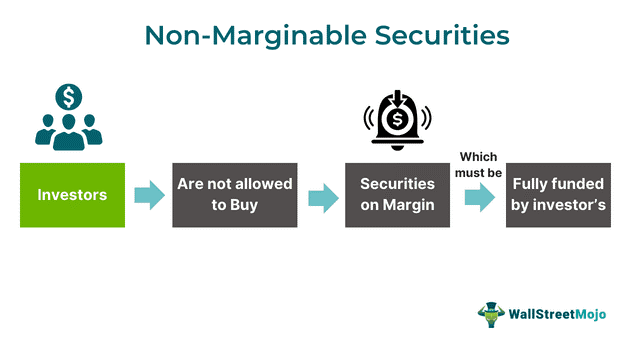Table of Contents
What Are Non-Marginable Securities?
Non-marginable securities are stocks that an investor cannot buy on margin. Such securities are traded on the exchange and can only be bought by paying their full amount through an investor's cash. They are placed to control costs and mitigate risks, especially for volatile stocks.

Every investor can use a margin account through which the brokerage firm allows them to invest in securities by paying half the amount of the securities, and the broker pays the other half. The investor is liable to pay interest to the broker. Typically, every firm defines and sets guidelines for which securities will be non-marginable.
Key Takeaways
- Non-marginable securities are those stocks and financial products that cannot be bought through a margin account but only through investors' cash.
- Typically, penny stocks, IPOs, and other OTC stocks are common forms of non-marginable securities prohibited by a brokerage firm.
- Primarily, every firm defines and sets guidelines for which securities will be non-marginable.
- These are good examples of how firms operate to ensure that investors are given facilities while restricting them from taking advantage of margin accounts, reducing risk and price volatility issues.
- Non-marginable securities are present to ensure that the investor does not invest without any guidelines, as buying securities on margin can be risky if the price does not move in the expected direction.
Non-Marginable Securities Explained
Non-marginable securities are stocks and other financial instruments that cannot be bought through a margin account and only require full cash payment from the investor. In financial markets, every investor buys securities through a broker or a brokerage firm. It is a direct buying option in which the whole purchase process is done through cash. In situations where the price of the underlying security moves against expectations, using margin can greatly increase losses but also amplify profits.
Now, investors are like clients to brokers, so if an investor wants to invest in some stocks but lacks funds, the firm lets them borrow funds to make purchases. It is a loan format in which the investor pays a particular interest to the broker for the borrowed money. For this to happen, an individual has to open a separate margin account with the broker, and all the securities bought and held in this account are used as collateral. The interest rate and collateral are present to mitigate the risk of default and loss from the investor's end. The critical aspect is that buying any stock through a margin account requires an investor to bring in 50% of the capital required and take the other 50% from the broker as a loan. In simple terms, if a stock's price is $90 and an investor wants to buy it through a margin account, they will have to bring in $45, and the broker lends the other half.
But again, a firm cannot allow investors to borrow funds to buy any security; therefore, the non-marginable securities list is off-limits and restricted from the broker's end. It is present to mitigate risk. Additionally, suppose an investor needs to support the interest payment and pay out the account maintenance fee. In that case, they will receive a margin call primarily within three days of such a scenario's existence. The call asks the investor to raise the required funds in the margin account.
Examples
Below are some examples to understand the topic better:
Example #1
Suppose Margaret has just started investing in the stock market. She has contacted a brokerage firm and invests her income monthly in different stocks. After nine months of regular investing, Margaret comes across a penny stock that she believes has huge growth potential.
She also believes that she should invest immediately, but again, Margaret is short on funds, so she decides to contact her broker to ensure she buys the penny stock on margin. Upon contact, the broker enlightens her that the penny stock falls under the category of non-marginable securities, and she can only buy the stock with her own money and in full payment.
Example #2
Suppose Margaret has just started investing in the stock market. She has contacted a brokerage firm and invests her income monthly in different stocks. After nine months of regular investing, Margaret comes across a penny stock that she believes has huge growth potential.
She also believes that she should invest immediately, but again, Margaret is short on funds, so she decides to contact her broker to ensure she buys the penny stock on margin. Upon contact, the broker enlightens her that the penny stock falls under the category of non-marginable securities, and she can only buy the stock with her own money and in full payment.
Marginal vs. Non-Marginable Securities
The primary differences between both concepts are as follows:
| Marginal Securities | Non-Marginable Securities |
|---|---|
| It can be bought through borrowed funds from a broker. | These are only bought through investors' cash. |
| These are riskier due to borrowed funds. | They are not riskier than marginal securities. |
| Investors pay interest on the borrowed funds to the broker. | This is not the case with these securities. |
| An investor must open a margin account to buy margin securities. | It is not required for this type of securities. |
